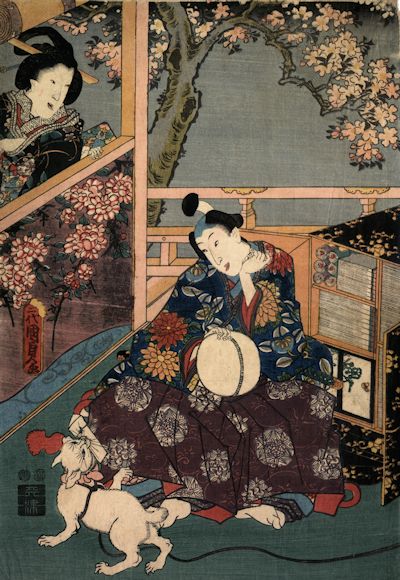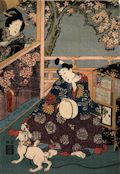| Title: |
Kashiwagi, from The False Murasaki's Rustic Gengi (A Spring Scene on The Porch) |
| Artist: |
Kunisada II, Utagawa (Japan, 1823 - 1880) |
| Date: |
1849 - 1853 |
| Medium: |
Original Japanese Woodcut |
| Publisher: |
Amatsu |
| Series: |
Nise murasaki inaka genji (The False Murasaki's Rustic Gengi) |
| Signature: |
Signed Nidai
Kunisada ga, (contains Kunisada Ga Seal - 1849 - 1853) |
| Note: |
The most dominant and influential movement of nineteenth
century Japanese woodcut art was the Utagawa School. As early as 1800,
Toyokuni had come to represent the father of this school. His style of
art was handed down to his greatest students, Kuniyoshi and Kunisada I, Utagawa 'Toyokuni III' (Japan, 1786 - 1864).
They in turn trained such fine artists as Kunisada II and Kunichika. Throughout
the century, Utagawa School artists were particularly adept at actor portrayals,
genre depictions and scenes from mythology and folklore. |
| |
Like the great schools of Japanese acting, the best Utagawa
artists often inherited their master's name. Kunisada II's first woodcuts
are signed with his original name, 'Kunimasa'. In 1846, however, he married
his master's daughter and secured the rights to sign his woodcuts, 'Kunisada
II'. And, from 1870, he further inherited the name of his master's master,
thus signing his art, 'Toyokuni III'. |
| |
Like Kunisada, Kunisada II was a master of colour and form.
Bold lines and gestures typically come to the fore in the art of both
masters. When the Western world first discovered the artistic value of
the Japanese woodcut (c. 1865), it was the designs of Kunisada and Kunisada
II which attracted the greatest attention. Their radical use of line and
perspective influenced an entire generation of European artists. Toulouse-Lautrec,
Whistler, Vuillard, Bonnard and many others owed a considerable deal to
the splendid art of these Japanese masters. |
| |
This nineteenth century Kunisada II woodcut hails from the Nise murasaki inaka genji (False Murasaki and a Rural Genji), published by Amatsu between 1849 and 1853. It depicts a spring scene on the porch with a cat delivering a letter in cherry-blossom season. The figure playing with a cat on the porch is most likely Genji's nephew, Kashiwagi, eldest son of To no Chujo who falls in love with Genj's young wife, the Third Princess, Onna San no Miya, daughter of Emperor Suzaku. The figure observing the lively scene over the railing is possibly the lovely, Onna San no Miya herself. It is a stunning example of the original art created by the Japanese artist, Kunisada II. |
| |
Nise murasaki inaka genji (False Murasaki and a Rural Genji): Japan’s most popular illustrated book of the early nineteenth century Nise murasaki inaka genji (False Murasaki and a Rural Genji) was a novel, written by Ryutei Tanehiko (1783-1842). It was an updated adaptation of the 11th century classic tale of Prince Genji, liberally borrowing scenes from contemporary novels and the kabuki theatre. To say that the novel was popular might be an understatement. Between 1829 and 1842 Ryutei Tanehiko published thirty-eight chapters or installments of Genji, each illustrated by Kunisada and his pupils. And, after the last chapter was published, the craze for scenes from Genji continued well into the century with the creation of further books by different authors and many more woodcuts on the Genji theme by not only Kunisada, but by such other great masters as Kuniyoshi, Yoshitoshi, Kunisada II, and other important Japanese artists. Such is the case with this original Utagawa Kunisada II woodcut, Kashiwagi which hails from The False Murasaki's Rustic Gengi. Ryutei Tanehiko's, Nise murasaki inaka genji follows the exploits of the handsome warrior, Ashikaga Mitsuuji (second son of the 8th Ashikaga Shogun, Yoshimasa), a character based upon the "Shining Prince Genji" (Hikaru Genji, son of the emperor by a favored lady). Unlike the eleventh century setting portraying Japanese court culture of the Heian period (794 - 1185), described in the Tale of Genji, a novel, composed by the Lady-in waiting, Murasaki Shikibu (c. 973 - c. 1014 / 1025), Tanehiko's, Nise murasaki inaka genji takes place during the fifteenth century Ashikaga Shogunate, a feudal samurai government ruled by the shoguns of the Ashikaga family (1336-1573). Unfortunately, although the setting was based in the Ashikaga Shogunate, it was believed the Inaka Genji reflected much of the current Shogun, Tokugawa Ienari, and his court. Consequently, in 1842, during the Tenpo Reforms, the woodblocks for the Inaka Genji were confiscated and Tanehiko was told to seize publication. Soon after (1842), Ryutei Tanehiko died, leaving the last two chapters of his book unpublished. |
| |
Cats in Japanese Mythology and Folklore: Old Japanese tales mention that some ordinary cats, with age, can belong to the family of Yokai (a general term for Japanese monsters). These cats are called 'Bakeneko', 'Nekomata', or 'Kasha'. Only the oldest and largest cats with the longest tails can become the feared, man eating, double or fork tailed cat monsters (Nekomata). The 'Kasha'. is believed to be a corps robber, but not to worry, the Kasha only steals the dead who in life have committed evil deeds of cruelty, wickedness and or debauchery, but thankfully, there are special tricks to protect your corpse from its claws. The Bakeneko also belongs another sub-group of Yokai known as 'Henge, Changelings or Shape Shifters', and can assume human form. The Bakeneko has often been portrayed by ukiyo-e artists of the edo period and in kabuki plays as a giant cat, ordinary cats wearing kimonos and cats disguised as beautiful women. There are countless stories surrounding these creatures and many are associated with women of ill repute. Although Bakeneko are believed to bring good fortune, some fear they are sinister creatures that should be avoided. The Japanese artist, Utagawa Kunyoshi was very fond of cats, even the paulownia flower seal Kuniyoshi uses below his signature is similar to that of a paw print. |
| Raisonne: |
Hiraki Ukiyo-e Foundation, Nyan to mo neko darake /Cats of Many Varieties (2012), #14; Marks et al, Genji's World (2012), list G347, |
| Size: |
Oban (Sizes in inches are approximate,
height preceding width of plate-mark or image.) |
| |
Framed and Matted with 100% Archival Materials |
| Condition: |
Printed upon mid nineteenth century mulberry (rice paper
and with full margins as published by Amatsu between 1849 and 1853. Containing
very slight rubbing and creasing along the right-hand margin, else Kashiwagi, from The False Murasaki's Rustic Gengi (A Spring Scene on The Porch) is a superb impression bearing all the fine
lines and vibrant colours of a very early printing. (One should note that
in this finely printed woodcut, blind printing without ink has been used
to simulate the fur of the cat in the foreground.) Altogether, this original
woodcut represents a stunning example of the original art of Kunisada
II. |
| Price: |
Sold - The price is no longer available. |
| Important Information: |
The artist biographies, research and or information pertaining to all the original works of art posted on our pages has been written and designed by Greg & Connie Peters exclusively for our site, (www.artoftheprint.com). Please visit us regularly to view the latest artworks offered for sale. We will soon be posting an update of our most recent research and include the biographical and historical information pertaining to our next collection of original works of art created by artists throughout the centuries. We hope you found the information you were looking for and that it has been beneficial.
Our Gallery, (Art of the Print / www.artoftheprint.com) guarantees the authenticity of every work of art we sell 100%. Full documentation and certification is provided. We offer a wide selection of international fine art dating from the early Renaissance to the contemporary art period. |







![]()
![]() or
phone Greg & Connie (905) 957-6666
or
phone Greg & Connie (905) 957-6666